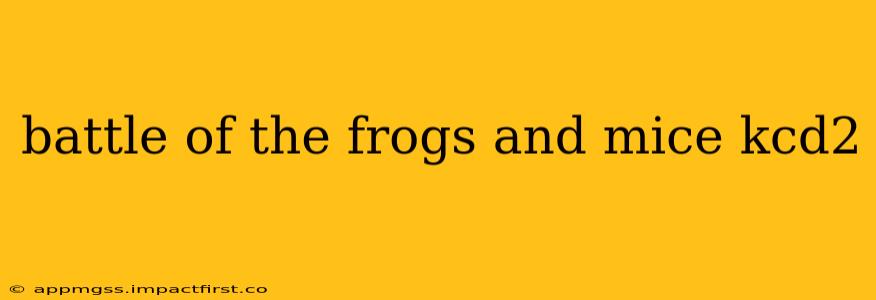The Battle of the Frogs and Mice, a fable with ancient roots, has captivated audiences for centuries. Its enduring appeal stems from its exploration of themes like power dynamics, social structures, and the consequences of rash decisions. This analysis will delve into the specific interpretation offered by KCD2 (presumably referring to a specific adaptation, commentary, or analysis of the fable), examining the nuances and insights it provides. While I don't have access to a specific "KCD2" interpretation, I can offer a comprehensive look at the fable and explore potential themes that a critical analysis like KCD2 might highlight.
What is the Battle of the Frogs and Mice About?
The core narrative typically involves a conflict between two seemingly disparate groups: frogs and mice. The mice, initially oppressed, seek an alliance with the frogs. However, this alliance quickly sours, exposing the inherent weaknesses and vulnerabilities of both sides. Ultimately, the conflict ends disastrously for both groups, often with a heavy loss of life and a stark reminder of the perils of misjudged alliances and power struggles.
Common Interpretations and Themes
Several key themes frequently emerge in interpretations of the Battle of the Frogs and Mice:
-
The Dangers of Unequal Alliances: The fable often serves as a cautionary tale against forging alliances based on convenience rather than shared goals and mutual respect. The disparity in power between frogs and mice proves disastrous.
-
The Illusion of Power: Both frogs and mice experience fleeting moments of perceived power, only to see it crumble under the weight of their poor decisions. This highlights the ephemeral nature of power and the importance of strategic thinking.
-
The Folly of Blind Ambition: The ambition of both groups, unchecked by reason or foresight, leads them down a path of destruction. The mice's initial hope for liberation quickly turns into a desperate struggle for survival.
-
The Importance of Prudence: The fable emphasizes the need for caution and careful planning, especially when dealing with those significantly different from oneself. A lack of foresight often leads to disastrous outcomes.
Potential Areas of Focus for a KCD2 Analysis
A critical analysis like KCD2 might explore several aspects of the fable in greater detail:
The Role of Leadership and Decision-Making: How do the leaders of the frogs and mice contribute to the conflict's escalation? A KCD2 analysis could analyze the effectiveness (or lack thereof) of their strategies and decision-making processes.
Social Structures and Power Dynamics: The fable presents a complex picture of social structures and power dynamics. KCD2 might examine how these elements influence the actions and motivations of the frogs and mice.
Moral Ambiguity: Are the frogs and mice equally culpable for the conflict's tragic outcome? A deeper analysis, such as KCD2, could explore the moral ambiguities of the situation and the nuances of responsibility.
Symbolic Interpretations: The frogs and mice could be seen as representing broader societal groups or abstract concepts. KCD2 could unpack the potential symbolic meanings embedded within the narrative.
Comparative Analysis: KCD2 could compare and contrast this version of the Battle of the Frogs and Mice with other iterations or related fables, highlighting variations and thematic consistencies.
While I cannot directly address the specific content of a hypothetical KCD2 interpretation, this analysis provides a framework for understanding the potential depth and scope of such an examination. The Battle of the Frogs and Mice remains a timeless fable, rich with meaning and offering ample opportunity for insightful critical analysis. The key is to explore the nuances, complexities, and underlying moral lessons embedded within its seemingly simple narrative.
